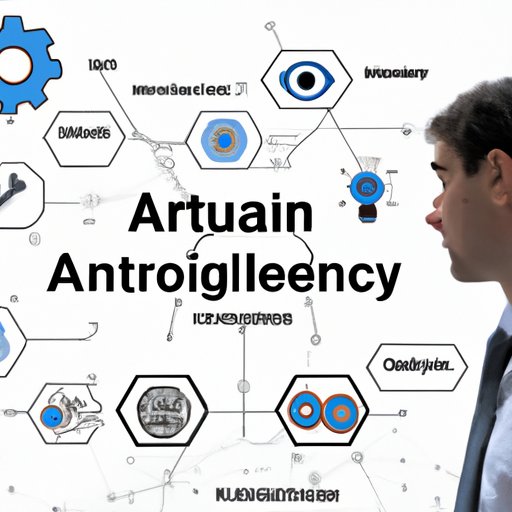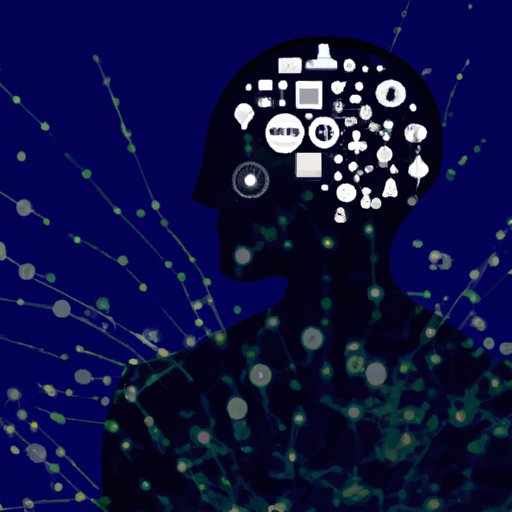Introduction
Artificial Intelligence (AI) has been a hot topic for many years, with people debating its implications and possibilities. But what is AI exactly? And what is it made from? To understand how AI works, it’s important to know the components that make up the technology and the underlying principles that govern its behavior.

Exploring the Components of Artificial Intelligence
At its core, AI is a type of computer programming that enables machines to learn from experience and data. This means that AI can take in information, process it, and make decisions without having to be explicitly programmed by humans. AI is made up of several components, which are essential to understanding how the technology works.
What is AI Made From?
AI is made up of a combination of algorithms, software, hardware, and data. Algorithms are sets of instructions that tell the computer how to complete a task. Software is the code that controls the algorithm. Hardware is the physical computer and associated devices needed to run the software. Finally, data provides the input that the algorithm needs to make decisions.
A Look at its Building Blocks
The building blocks of AI include machine learning, deep learning, natural language processing, computer vision, robotics, and automation. Machine learning is a type of AI that uses algorithms to analyze data and make predictions. Deep learning is a subset of machine learning that focuses on neural networks, or networks of simulated neurons that can detect patterns in data. Natural language processing is a branch of AI that enables computers to interpret and interact with human language. Computer vision is a type of AI that enables machines to recognize objects in images and videos. Robotics is a field of engineering focused on creating robots that can sense and act autonomously. Automation is the use of technology to automate tasks that would normally be done manually.
An Overview of AI and its Core Technologies
Now that we’ve explored the components that make up AI, let’s take a look at the basics of how it works. AI systems are powered by algorithms and tools. An algorithm is a set of instructions that tells the computer how to complete a task. Tools are the software and hardware used to execute the algorithm and process data. These algorithms and tools enable AI systems to interpret data, make decisions, and perform tasks.
The Basics of How It Works
AI systems are trained using algorithms and data. The algorithms are used to identify patterns and relationships in the data. As the system processes more data, it becomes better at recognizing patterns and making decisions. This is known as machine learning. AI systems can also be trained using reinforcement learning, where the system is rewarded when it makes correct decisions.
Understanding its Algorithms and Tools
AI algorithms come in two main forms: supervised and unsupervised. Supervised algorithms are trained using labeled data, meaning the data is labeled with the correct answer. Unsupervised algorithms are trained using unlabeled data, meaning the system must figure out the correct answer on its own. AI systems also rely on tools such as neural networks, which are networks of simulated neurons that can detect patterns in data. Other tools include genetic algorithms, which use evolutionary principles to find solutions to complex problems.

The Power of AI: Unveiling its Complexities
AI has the potential to revolutionize the way we live and work. It can improve decision-making processes, automate mundane tasks, and even create new products and services. However, there are also some potential drawbacks to AI, such as privacy concerns and bias in algorithms.
Benefits of AI
AI has the potential to make life easier and more efficient. It can reduce costs, increase productivity, and improve decision-making. AI can also help us make sense of large amounts of data, enabling us to gain insights into trends and patterns that would otherwise be difficult to discern. According to a study by Accenture, AI could add an additional $14 trillion to the global economy by 2035.
Challenges Facing AI
In addition to its potential benefits, AI also poses some potential risks. There are concerns about privacy, as AI systems may collect and store large amounts of personal data. There are also ethical concerns about the use of AI, as some worry that the technology could be used to unfairly discriminate against certain groups. Finally, there are technical challenges, such as ensuring that AI systems are reliable and secure.
Conclusion
In conclusion, AI is a powerful technology that has the potential to revolutionize the way we live and work. It is made up of several components, including algorithms, software, hardware, and data. AI systems are powered by algorithms and tools, which enable them to interpret data, make decisions, and perform tasks. Finally, while AI has the potential to bring great benefits, there are also potential risks and challenges that must be addressed.
Summary of Key Points
This article explored the components that make up Artificial Intelligence and how it works. We looked at its building blocks, algorithms, tools, and data, as well as the potential benefits and challenges it poses. Ultimately, AI is a powerful technology that has the potential to revolutionize the way we live and work, but it must be used responsibly.
Recommendations for Further Research
Further research is needed to explore the potential applications of AI and the ethical considerations that must be taken into account. Additionally, research is needed to develop methods for ensuring the reliability and security of AI systems. Finally, research should be conducted to investigate the potential risks posed by AI and the steps that can be taken to mitigate these risks.
(Note: Is this article not meeting your expectations? Do you have knowledge or insights to share? Unlock new opportunities and expand your reach by joining our authors team. Click Registration to join us and share your expertise with our readers.)
